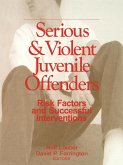Violent and Sexual Offenders
Assessment, Treatment and Management
Herausgeber: Ireland, Jane; Birch, Philip; Ireland, Carol
Violent and Sexual Offenders
Assessment, Treatment and Management
Herausgeber: Ireland, Jane; Birch, Philip; Ireland, Carol
- Gebundenes Buch
- Merkliste
- Auf die Merkliste
- Bewerten Bewerten
- Teilen
- Produkt teilen
- Produkterinnerung
- Produkterinnerung
Building on the success of the first edition and the growth of research in the field over the past decade, this expanded new edition offers an authoritative overview of the assessment, treatment and management of violent and sexual offenders.
Andere Kunden interessierten sich auch für
![Dangerousness, Risk and the Governance of Serious Sexual and Violent Offenders Dangerousness, Risk and the Governance of Serious Sexual and Violent Offenders]() Karen HarrisonDangerousness, Risk and the Governance of Serious Sexual and Violent Offenders76,99 €
Karen HarrisonDangerousness, Risk and the Governance of Serious Sexual and Violent Offenders76,99 €![Serious and Violent Juvenile Offenders Serious and Violent Juvenile Offenders]() Rolf LoeberSerious and Violent Juvenile Offenders239,99 €
Rolf LoeberSerious and Violent Juvenile Offenders239,99 €![Serious and Violent Juvenile Offenders Serious and Violent Juvenile Offenders]() Rolf Loeber / David P. Farrington (eds.)Serious and Violent Juvenile Offenders195,99 €
Rolf Loeber / David P. Farrington (eds.)Serious and Violent Juvenile Offenders195,99 €![Psychological Criminology Psychological Criminology]() Richard WortleyPsychological Criminology196,99 €
Richard WortleyPsychological Criminology196,99 €![Violent Femmes Violent Femmes]() Rosie WhiteViolent Femmes80,99 €
Rosie WhiteViolent Femmes80,99 €![Understanding Violent Criminals Understanding Violent Criminals]() David ThomasUnderstanding Violent Criminals72,99 €
David ThomasUnderstanding Violent Criminals72,99 €![A Violent Heart A Violent Heart]() Gregory K. MoffattA Violent Heart42,99 €
Gregory K. MoffattA Violent Heart42,99 €-
-
-
Building on the success of the first edition and the growth of research in the field over the past decade, this expanded new edition offers an authoritative overview of the assessment, treatment and management of violent and sexual offenders.
Hinweis: Dieser Artikel kann nur an eine deutsche Lieferadresse ausgeliefert werden.
Hinweis: Dieser Artikel kann nur an eine deutsche Lieferadresse ausgeliefert werden.
Produktdetails
- Produktdetails
- Verlag: Routledge
- 2. Auflage
- Seitenzahl: 576
- Erscheinungstermin: 22. August 2018
- Englisch
- Abmessung: 250mm x 175mm x 35mm
- Gewicht: 1160g
- ISBN-13: 9781138233096
- ISBN-10: 1138233099
- Artikelnr.: 53778227
- Herstellerkennzeichnung
- Libri GmbH
- Europaallee 1
- 36244 Bad Hersfeld
- gpsr@libri.de
- Verlag: Routledge
- 2. Auflage
- Seitenzahl: 576
- Erscheinungstermin: 22. August 2018
- Englisch
- Abmessung: 250mm x 175mm x 35mm
- Gewicht: 1160g
- ISBN-13: 9781138233096
- ISBN-10: 1138233099
- Artikelnr.: 53778227
- Herstellerkennzeichnung
- Libri GmbH
- Europaallee 1
- 36244 Bad Hersfeld
- gpsr@libri.de
Jane L. Ireland, Chartered Psychologist, Forensic Psychologist, and Chartered Scientist, holds a professorial chair at the University of Central Lancashire and is Violence Treatment Lead within High Secure Services, Ashworth Hospital, Mersey Care NHS Trust. She is elected academy fellow of the Council of the Academy of Social Sciences and fellow of the International Society for Research on Aggression (ISRA). She regularly publishes in the area of aggression and leads the Ashworth Research Centre (ARC) within Mersey Care NHS Trust. Carol A. Ireland, Consultant Chartered Psychologist, Forensic Psychologist, and Chartered Scientist, is Lead Trainer for the Life Minus Violence Harmful Sexual Behaviour Therapy, and Senior Research Lead at the Ashworth Research Centre. She also works at the University of Central Lancashire, where she is the Director of Studies for the MSc in Forensic Psychology. She also works at the Coastal Child and Adult Therapeutic Services (CCATS). Philip Birch is a Senior Lecturer in Criminology in the Centre for Law and Justice at Charles Sturt University, Australia. Prior to entering academia Philip worked as a criminologist in the field, holding posts in the UK Prison Service as well as in the crime and disorder field, which involved managing a specialist crime unit. Philip is an honorary research fellow within the Forensic Centre, UCLan, UK, and a senior research associate at Ashworth Research Centre, Ashworth Hospital, UK.
Foreword
David P. Farrington
Section I: Risk assessment - Current perspectives. 1. Violence risk assessment
Robyn Mooney and Ivan Sebalo
2. Thinking outside of the box: the assessment of sexual offending recidivism and specialist populations
Neil Gredecki and Kerensa Hocken
3. Intimate partner violence risk assessment
P. Randall Kropp
4. Assessment of internet-related sexual offenders
Derek Perkins
5. Risk assessment and management of violent extremists and terrorists: Background
principles and practice
D. Elaine Pressman
6. Assessing violence risk in youth
Andrew L. Gray
Catherine S. Shaffer
Jodi L. Viljoen
Nicole M. Muir and Tonia L. Nicholls
7. Family Lovemap and protective factors: Sex
intimacy
and sexually abusive youth
L.C. Miccio-Fonseca
8. Assessing women who sexually abuse children
Hilary J. Eldridge
Ian A. Elliott
Steven M. Gillespie
Alexandra Bailey and Anthony R. Beech
9. Assessing violence and sexual risk among offenders with cognitive intellectual difficulties
Nicola Manning
10. Protective factors for violence risk: Additional value to the risk focused approach
Michiel de Vries Robbé
11. Violence risk assessment in women: The value of the Female Additional Manual
Vivienne de Vogel
Miriam Wijkman and Michiel de Vries Robbé
Section II: Clinical assessment - Current perspectives. 12. Individual assessments of aggression: Accounting for core factors
Jane L. Ireland
13. Assessing the therapeutic needs of sexual offenders
Carisa Collins
Leigh Harkins and Laleh Dadgardoust
14. Assessing the clinical needs for stalking and domestic violence
Werner Tschan
15. Assessing the clinical needs for intellectually disabled sex offenders
Chanelle Salonia
Heather Hermans and David Hingsburger
16. Assessing for psychopathy using the Psychopathy Checklist
Michael Lewis
17. Using offence drivers to guide conceptualisation and treatment of trauma in male sex offenders
Ronald J. Ricci and Cheryl A. Clayton
18. The background and clinical use of the Dynamic Appraisal of Situational Aggression -Inpatient Version
DASA-IV: Application to a secure setting
Mark W. Thorpe
Panchu F. Xavier
Michael Daffern and Ashley L. Dunne
Section III: Treatment - Current perspectives. 19. Therapeutic treatment approaches for violence: Some essential components
Jane L. Ireland and Carol A. Ireland
20. Treatment approaches for sexual violence
Carol A. Ireland and Rachel Worthington
21. Adapting and evaluating treatment approaches for intellectually disabled sex offenders
John Rose
22. Beyond traditional treatment approaches for intimate partner violence: Integrating a dyadic perspective
Lindsey M. Rodriguez
Nicholas A. Armenti and Julia C. Babcock
23. Treatment of internet-related sexual offenders
Derek Perkins and Sarah Wefers
24. Treatment approaches for stalking
Rosemary Purcell and Troy McEwan
25. Treatment approaches for terrorists and extremists
Kurt Braddock
26. Treatment approaches for women who sexually abuse children
Hilary J. Eldridge
Alexandra Bailey and Sheila Brotherston
Section IV: Management - Current perspectives. 27. Offender supervision and compliance: Managing violent and sexual offenders in the community
Chris Trotter
28. Preventative detention and extended sentences: A regressive approach to managing violent and sexual offenders?
Andy Williams
29. Managing violent and sexual offenders in contemporary technoculture
Mike Nellis and Nicol Shadbolt
30. Sex Offender Registration and public protection: Rethinking the management of sex offenders in the community
Philip Birch and Emma Wintle
31. The importance of throughcare and resettlement for working with violent and sexual offenders
Julie Trebilcock and Anne Worrall
32. Desistance: Lessons learnt for managing violent and sexual offenders
Brian Stout
David P. Farrington
Section I: Risk assessment - Current perspectives. 1. Violence risk assessment
Robyn Mooney and Ivan Sebalo
2. Thinking outside of the box: the assessment of sexual offending recidivism and specialist populations
Neil Gredecki and Kerensa Hocken
3. Intimate partner violence risk assessment
P. Randall Kropp
4. Assessment of internet-related sexual offenders
Derek Perkins
5. Risk assessment and management of violent extremists and terrorists: Background
principles and practice
D. Elaine Pressman
6. Assessing violence risk in youth
Andrew L. Gray
Catherine S. Shaffer
Jodi L. Viljoen
Nicole M. Muir and Tonia L. Nicholls
7. Family Lovemap and protective factors: Sex
intimacy
and sexually abusive youth
L.C. Miccio-Fonseca
8. Assessing women who sexually abuse children
Hilary J. Eldridge
Ian A. Elliott
Steven M. Gillespie
Alexandra Bailey and Anthony R. Beech
9. Assessing violence and sexual risk among offenders with cognitive intellectual difficulties
Nicola Manning
10. Protective factors for violence risk: Additional value to the risk focused approach
Michiel de Vries Robbé
11. Violence risk assessment in women: The value of the Female Additional Manual
Vivienne de Vogel
Miriam Wijkman and Michiel de Vries Robbé
Section II: Clinical assessment - Current perspectives. 12. Individual assessments of aggression: Accounting for core factors
Jane L. Ireland
13. Assessing the therapeutic needs of sexual offenders
Carisa Collins
Leigh Harkins and Laleh Dadgardoust
14. Assessing the clinical needs for stalking and domestic violence
Werner Tschan
15. Assessing the clinical needs for intellectually disabled sex offenders
Chanelle Salonia
Heather Hermans and David Hingsburger
16. Assessing for psychopathy using the Psychopathy Checklist
Michael Lewis
17. Using offence drivers to guide conceptualisation and treatment of trauma in male sex offenders
Ronald J. Ricci and Cheryl A. Clayton
18. The background and clinical use of the Dynamic Appraisal of Situational Aggression -Inpatient Version
DASA-IV: Application to a secure setting
Mark W. Thorpe
Panchu F. Xavier
Michael Daffern and Ashley L. Dunne
Section III: Treatment - Current perspectives. 19. Therapeutic treatment approaches for violence: Some essential components
Jane L. Ireland and Carol A. Ireland
20. Treatment approaches for sexual violence
Carol A. Ireland and Rachel Worthington
21. Adapting and evaluating treatment approaches for intellectually disabled sex offenders
John Rose
22. Beyond traditional treatment approaches for intimate partner violence: Integrating a dyadic perspective
Lindsey M. Rodriguez
Nicholas A. Armenti and Julia C. Babcock
23. Treatment of internet-related sexual offenders
Derek Perkins and Sarah Wefers
24. Treatment approaches for stalking
Rosemary Purcell and Troy McEwan
25. Treatment approaches for terrorists and extremists
Kurt Braddock
26. Treatment approaches for women who sexually abuse children
Hilary J. Eldridge
Alexandra Bailey and Sheila Brotherston
Section IV: Management - Current perspectives. 27. Offender supervision and compliance: Managing violent and sexual offenders in the community
Chris Trotter
28. Preventative detention and extended sentences: A regressive approach to managing violent and sexual offenders?
Andy Williams
29. Managing violent and sexual offenders in contemporary technoculture
Mike Nellis and Nicol Shadbolt
30. Sex Offender Registration and public protection: Rethinking the management of sex offenders in the community
Philip Birch and Emma Wintle
31. The importance of throughcare and resettlement for working with violent and sexual offenders
Julie Trebilcock and Anne Worrall
32. Desistance: Lessons learnt for managing violent and sexual offenders
Brian Stout
Foreword
David P. Farrington
Section I: Risk assessment - Current perspectives. 1. Violence risk assessment
Robyn Mooney and Ivan Sebalo
2. Thinking outside of the box: the assessment of sexual offending recidivism and specialist populations
Neil Gredecki and Kerensa Hocken
3. Intimate partner violence risk assessment
P. Randall Kropp
4. Assessment of internet-related sexual offenders
Derek Perkins
5. Risk assessment and management of violent extremists and terrorists: Background
principles and practice
D. Elaine Pressman
6. Assessing violence risk in youth
Andrew L. Gray
Catherine S. Shaffer
Jodi L. Viljoen
Nicole M. Muir and Tonia L. Nicholls
7. Family Lovemap and protective factors: Sex
intimacy
and sexually abusive youth
L.C. Miccio-Fonseca
8. Assessing women who sexually abuse children
Hilary J. Eldridge
Ian A. Elliott
Steven M. Gillespie
Alexandra Bailey and Anthony R. Beech
9. Assessing violence and sexual risk among offenders with cognitive intellectual difficulties
Nicola Manning
10. Protective factors for violence risk: Additional value to the risk focused approach
Michiel de Vries Robbé
11. Violence risk assessment in women: The value of the Female Additional Manual
Vivienne de Vogel
Miriam Wijkman and Michiel de Vries Robbé
Section II: Clinical assessment - Current perspectives. 12. Individual assessments of aggression: Accounting for core factors
Jane L. Ireland
13. Assessing the therapeutic needs of sexual offenders
Carisa Collins
Leigh Harkins and Laleh Dadgardoust
14. Assessing the clinical needs for stalking and domestic violence
Werner Tschan
15. Assessing the clinical needs for intellectually disabled sex offenders
Chanelle Salonia
Heather Hermans and David Hingsburger
16. Assessing for psychopathy using the Psychopathy Checklist
Michael Lewis
17. Using offence drivers to guide conceptualisation and treatment of trauma in male sex offenders
Ronald J. Ricci and Cheryl A. Clayton
18. The background and clinical use of the Dynamic Appraisal of Situational Aggression -Inpatient Version
DASA-IV: Application to a secure setting
Mark W. Thorpe
Panchu F. Xavier
Michael Daffern and Ashley L. Dunne
Section III: Treatment - Current perspectives. 19. Therapeutic treatment approaches for violence: Some essential components
Jane L. Ireland and Carol A. Ireland
20. Treatment approaches for sexual violence
Carol A. Ireland and Rachel Worthington
21. Adapting and evaluating treatment approaches for intellectually disabled sex offenders
John Rose
22. Beyond traditional treatment approaches for intimate partner violence: Integrating a dyadic perspective
Lindsey M. Rodriguez
Nicholas A. Armenti and Julia C. Babcock
23. Treatment of internet-related sexual offenders
Derek Perkins and Sarah Wefers
24. Treatment approaches for stalking
Rosemary Purcell and Troy McEwan
25. Treatment approaches for terrorists and extremists
Kurt Braddock
26. Treatment approaches for women who sexually abuse children
Hilary J. Eldridge
Alexandra Bailey and Sheila Brotherston
Section IV: Management - Current perspectives. 27. Offender supervision and compliance: Managing violent and sexual offenders in the community
Chris Trotter
28. Preventative detention and extended sentences: A regressive approach to managing violent and sexual offenders?
Andy Williams
29. Managing violent and sexual offenders in contemporary technoculture
Mike Nellis and Nicol Shadbolt
30. Sex Offender Registration and public protection: Rethinking the management of sex offenders in the community
Philip Birch and Emma Wintle
31. The importance of throughcare and resettlement for working with violent and sexual offenders
Julie Trebilcock and Anne Worrall
32. Desistance: Lessons learnt for managing violent and sexual offenders
Brian Stout
David P. Farrington
Section I: Risk assessment - Current perspectives. 1. Violence risk assessment
Robyn Mooney and Ivan Sebalo
2. Thinking outside of the box: the assessment of sexual offending recidivism and specialist populations
Neil Gredecki and Kerensa Hocken
3. Intimate partner violence risk assessment
P. Randall Kropp
4. Assessment of internet-related sexual offenders
Derek Perkins
5. Risk assessment and management of violent extremists and terrorists: Background
principles and practice
D. Elaine Pressman
6. Assessing violence risk in youth
Andrew L. Gray
Catherine S. Shaffer
Jodi L. Viljoen
Nicole M. Muir and Tonia L. Nicholls
7. Family Lovemap and protective factors: Sex
intimacy
and sexually abusive youth
L.C. Miccio-Fonseca
8. Assessing women who sexually abuse children
Hilary J. Eldridge
Ian A. Elliott
Steven M. Gillespie
Alexandra Bailey and Anthony R. Beech
9. Assessing violence and sexual risk among offenders with cognitive intellectual difficulties
Nicola Manning
10. Protective factors for violence risk: Additional value to the risk focused approach
Michiel de Vries Robbé
11. Violence risk assessment in women: The value of the Female Additional Manual
Vivienne de Vogel
Miriam Wijkman and Michiel de Vries Robbé
Section II: Clinical assessment - Current perspectives. 12. Individual assessments of aggression: Accounting for core factors
Jane L. Ireland
13. Assessing the therapeutic needs of sexual offenders
Carisa Collins
Leigh Harkins and Laleh Dadgardoust
14. Assessing the clinical needs for stalking and domestic violence
Werner Tschan
15. Assessing the clinical needs for intellectually disabled sex offenders
Chanelle Salonia
Heather Hermans and David Hingsburger
16. Assessing for psychopathy using the Psychopathy Checklist
Michael Lewis
17. Using offence drivers to guide conceptualisation and treatment of trauma in male sex offenders
Ronald J. Ricci and Cheryl A. Clayton
18. The background and clinical use of the Dynamic Appraisal of Situational Aggression -Inpatient Version
DASA-IV: Application to a secure setting
Mark W. Thorpe
Panchu F. Xavier
Michael Daffern and Ashley L. Dunne
Section III: Treatment - Current perspectives. 19. Therapeutic treatment approaches for violence: Some essential components
Jane L. Ireland and Carol A. Ireland
20. Treatment approaches for sexual violence
Carol A. Ireland and Rachel Worthington
21. Adapting and evaluating treatment approaches for intellectually disabled sex offenders
John Rose
22. Beyond traditional treatment approaches for intimate partner violence: Integrating a dyadic perspective
Lindsey M. Rodriguez
Nicholas A. Armenti and Julia C. Babcock
23. Treatment of internet-related sexual offenders
Derek Perkins and Sarah Wefers
24. Treatment approaches for stalking
Rosemary Purcell and Troy McEwan
25. Treatment approaches for terrorists and extremists
Kurt Braddock
26. Treatment approaches for women who sexually abuse children
Hilary J. Eldridge
Alexandra Bailey and Sheila Brotherston
Section IV: Management - Current perspectives. 27. Offender supervision and compliance: Managing violent and sexual offenders in the community
Chris Trotter
28. Preventative detention and extended sentences: A regressive approach to managing violent and sexual offenders?
Andy Williams
29. Managing violent and sexual offenders in contemporary technoculture
Mike Nellis and Nicol Shadbolt
30. Sex Offender Registration and public protection: Rethinking the management of sex offenders in the community
Philip Birch and Emma Wintle
31. The importance of throughcare and resettlement for working with violent and sexual offenders
Julie Trebilcock and Anne Worrall
32. Desistance: Lessons learnt for managing violent and sexual offenders
Brian Stout








